Brocaded okbash
From: Yon Bard
I just acquired the okbash shown below. It is plain-weave with the design in brocade: The supplemental wefts pass over three warps on the face and one warp on the back, reversing direction at the edge of each colored stripe. The seller referred to it as Yomud, but I have no idea whether that is correct. Does anyone know of any analogs, or at least similar pieces done in the same technique?
Regards, Yon

From: John Howe
Hi Yon -
I own a flatwoven okbash. I'm not too reliable on analyzing flatweaves (actually I get bored with it rather quickly) but mine has some similarity in design and may be of a similar technique.
I bought my piece from Anne Halley who speculated that it might be Saryk on the basis of the darkish color pallette and the tassel treatment. It is woven very well. I think of no great age though.
I don't have any photos of it but am emailing you two direct scans of portions of it, one of the front side and the other of the back. I won't reduce the size of the scanned images so you have a chance to look at structure more closely.
The colors on your would fit with a Yomut attribution for me.
Regards,
R. John Howe
From: Steve Price
Hi Yon,
I don't know how to attribute Turkmen flatweaves, and I don't know of any published treatment of the group at all. I wonder if any of our readers would be interested in preparing a Salon essay on the subject. Not a major research paper, mostly an illustrated list of questions and suggestions for how they might be answered.
Regards,
Steve Price
From: Lavergne Philippe
I have two bad pictures of two ersari ok-bashs : they are quite the same than the two you can see in " The Ersari and their weavings, International Hajji Baba Society, Inc, Washington,DC,1975, n° 50.
I send the pictures to Steven
From: Steve Price
Hi People,
Here are the two images Lavergne Philippe sent to me.
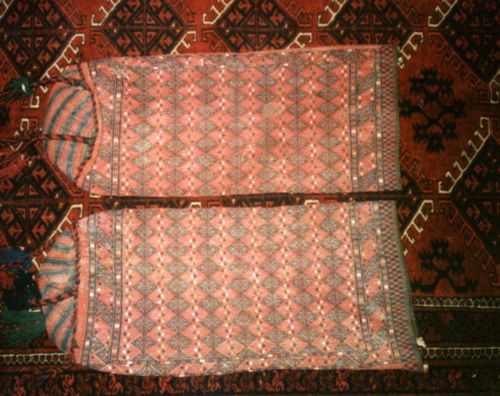
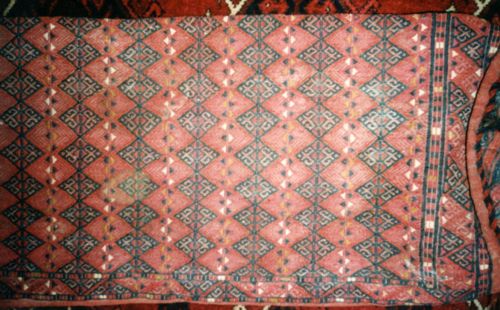
Thanks,
Steve Price
From: Yon Bard
John, your okbash seems to be woven in the same technique as mine, but with more of the background exposed.
Laverne, I cannot tell from your picyures exectly what technique is used.
Thanks to you both for your contributions. It's really an area that could merit some research. I am not sure enough is known to support a Salon, but you never know what'll turn up.
Regards, Yon
From: R. John Howe
Yon, Steve et al -
Anne Halley said to me as we were discussing my piece, that this is an area that George O'Bannon was studying before he died.
Someone else told me that Andy Hale has taken up parts of that work (and Andy wrote something about non-Turkmen Central Asian weaving in Hali last issue).
It, for example, may not be an accident that Andy's wife Kate Fitz Gibbons' talk at the TM Convention, emphasized so strongly that we are using the term "Lakai" far too broadly. Although another group entirely, all the Lakai pieces I have seen are on the flatweave side.
Perhaps Kate and Andy might be contacted by someone who knows them.
Regards,
R. John Howe
From: Yon Bard
John, all the Lakai pieces are (as far as I know) embroideries (silk on cotton?) whereas these okbashes are brocades of wool on wool. The difference is that embroidery is done with a needle on a fully woven piece of cloth and the threads can go in any direction, whereas a brocade is done completely on the loom, with the supplementary wefts being put down alongside the ground wefts as the weaving progresses.
Regards, Yon
From: Filiberto Boncompagni
Hi John,
Here are the pictures of your piece:
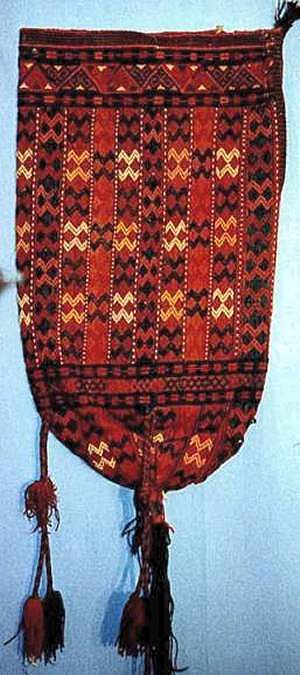
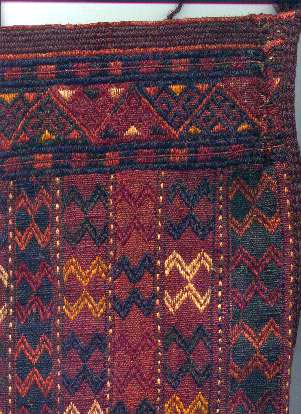
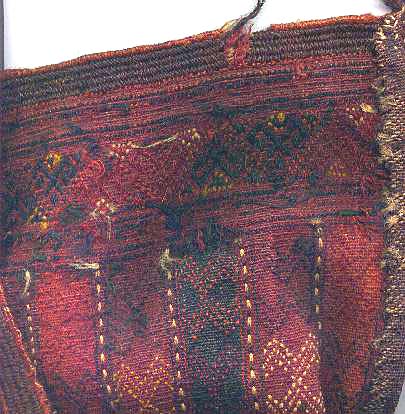
Regards,
Filiberto
From: R. John Howe
Thanks, Filiberto.
Dear folks -
You can see that I spoke too soon above about not having a photo. I found that I had one but it was in a Word format. Filiberto has kindly made it possible to post it. The second image is direct scan of a detail of the front and the third image is a direct scan of a detail of the back.
The piece has a slit on the side of the open end to facilitate getting it over the bundled tent poles. Something we apparently have few or no photos of so far.
As I said, it's extremely sturdily made. It would stand up to such use.
Regards,
R. John Howe
From: R. John Howe
Yon -
I was clear that Lakai pieces are quite distinctive. I was merely speculating about who might be studying Turkmen flatweaves now that George has died. I felt that Kate and especially Andy might be possibilities. Marla and Christopher Huber have been studying mixed technique Turkmen tent bands but I'm not sure Marla has ventured further into Turkmen flatweaves in general.
Interestingly, Eiland and Pinner make a kind of bow to Turkmen flatweaves in their catalog on the Wiedersperg Collection. There are two "palas" pieces in that collection and they are not sure whether they are Tekke or Yomut. In their footnote 97, they list five other publications that have talked about Turkmen flatweaves. Some of the items cited (Thacher!) are quite old, suggesting that things have not moved much.
Regards,
R. John Howe
From: Yon Bard
John, what are "palas" pieces?
Regards, Yon
From: R. John Howe
Yon -
They are a kind of flatwoven rug. These two vary between 120 inches and 140 inches in length and both are 76 inches wide.
I can send you images and pretty good technical descriptions if you like.
If you don't own this catalog, I think it is worth buying ($30 in paper). It's entitled "Between the Black Desert and the Red." Michael Franses was critical of it in his Hali review. He went on and on about why Eiland and Pinner didn't get an editor and how inconsistently they had used "gul" and "gol," but I quite like it, in part because it seems to me that the authors not only spoke to the material in this collection (and some have complained about this collection, too) but they also tried to give a kind of sense of the state of the art in Turkmen studies as they went along.
Regards,
R. John Howe
From: Marvin Amstey
I'll throw one more wrench into the machinery. The weave of these weavings looks very much like some Ersari Ok-bashes that John Wertime had a few years ago. Unfortunately, I'm speculating on this from looking at my monitor and not handling the pieces. Nonetheless, they are attractive weavings; wish I knew what they were used for
Regards,
Marvin
From: Yon Bard
Marvin, perhaps you could post the images that you are looking at on your screen?
Regards, Yon
From: Steve Price
Hi People,
Phillippe Lavergne sent me these images of a brocaded flatwoven Turkmen piece that belongs to him.

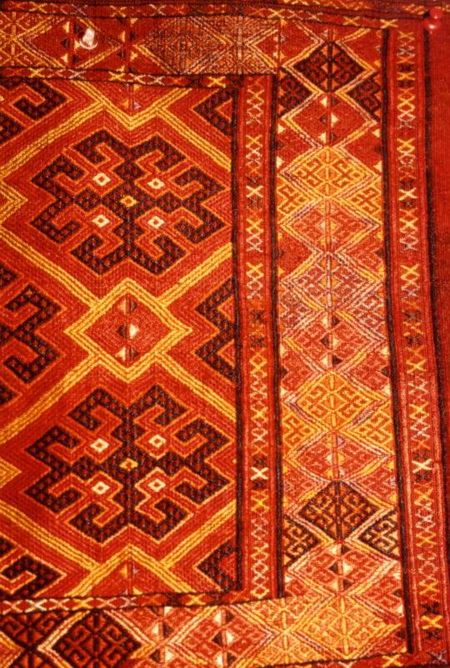
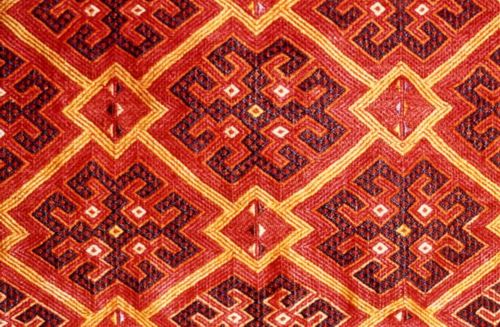
Phil tells me that the piece has lots of silk in it. This makes me wonder whether the conventional notion that the Turkmen flatweaves weren't "special occasion" stuff, but were for everyday use, isn't off base.
Regards, and thanks, Phil.
Regards,
Steve Price
From: Marvin Amstey
Sorry, Yon. I didn't make myself clear. The images to which I referred are the ones of the Okbash already posted.
From: Chuck Wagner
Yon et all,
I have a silk brocaded jollar very similar to Phils. For what it's worth, the brocade structure is similar to the okbash: the supplemental wefts passing over three warps.
There is a very good photo of a large all wool broceded Yomut flatweave rug, with a good detail photo of the back of the rug, in: KILIM: The Complete Guide. pp. 254., by Hull and Luczyc-Wyhowska.
The rug in the book is undated but looks 1960's to me; I know they're still being woven today. We see new ones as well as old ones in the market here from time to time.
I can see that the okbash is older, but as you've all noted there is very little scholarly work on Turkmen flatweaves that is easily accessible.
If you're interested I can try to get the detail image scanned in tomorrow; I don't have a scanner at home.
For those with interest in Lakai Uzbek embroidery and other Central Asian textiles, I suggest scaring up a copy of Janet Harvey's "Traditional Textiles of Central Asia". Because of my location and the large number of Afghanis in the rug business here, I see a lot of this stuff. The book is good. It's lavishly illustrated with very crisp color photos. It does not contain details on structure, however.
..Chuck
From: R. John Howe
Dear folks -
Chuck Wagner is right to mention the Hull/Luczyc-Wyhowska, volume "The Complete Kilim Guide." It provides far more than one more example for this thread. All of Chapter Seven is devote to Afghanistan and Central Asian flatweaves. A number of Turkmen designs are shown as well as a great deal of non-Turkmen material. As Chuck says, some of this material is still being woven today.
Regards,
R. John Howe
From: Robert Emry
Turkmen flatweaves
I've also acquired several Turkmen flatweaves recently and find them fascinating, but I'm also wondering about tribal attributions. For example, what identifies the Okbashes (what's the plural of that word anyway?) posted above as Yomud? or Ersari? I've only begun to try to understand the structure, but clearly it is variable. In the brocading, or weft wrapping, the "over three" seems to be common, but the "under one" depends to some extent on the design being created. Here are a couple pictures of a small okbash:
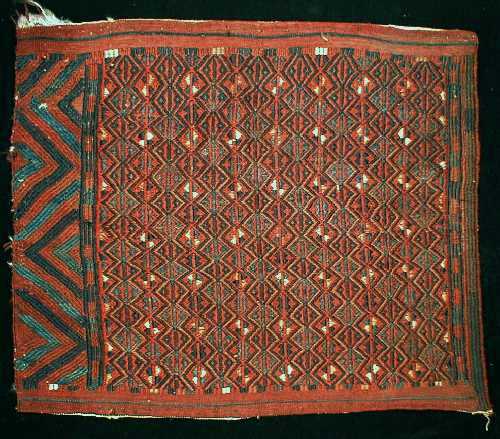
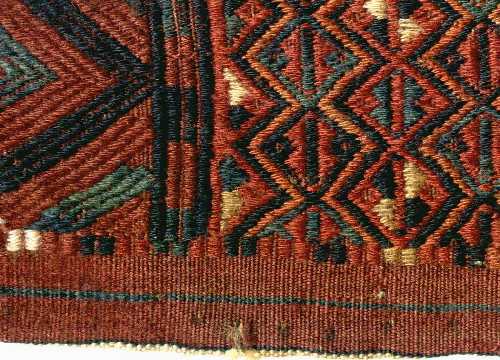
Here, the structure of the zig-zag design (which would be at the conical end of the cylindrical bag)is all in supplemental wefts that are over three under one. The same is true of the small border around around the field design, and separating the field from the zig-zag end. The field design however is mostly of diagonals, which are created by each yarn progressing upward, over three-under two and up (under the next ground weft). And the small triangles within each diamond are over a variable number of warps, from one to five. The weave is relatively fine--about 18 warps/inch.
The Afghani I acquired this one from called it Yomud, but I don't know why, and he probably doesn't know either. Some, like the torba, with silk, seen above in this thread, have designs that appear rarely in pile bags, but most of these flatweave designs don't. John Howe mentioned a possible Saryk attribution based on color and tassel structure. Is this the kind of criteria we're left with to begin to sort out the tribal attributions?
Cheers,
Bob Emry
From: Chuck Wagner
A Research Topic for the Neurology Department
So, there I was, staring at a detailed photo of the FRONT of a Yomut flatweave rug, thinking to myself "Wouldn't it be nice if more of these people had photos of the BACK of the rugs in their books", and proceeded to type BACK instead of FRONT. I then stared straight at my faux pas during the editing portion of the project and proceeded to miss it a second time.
To anyone who drove 100 miles in a driving blizzard to get this book (the Hull/Luczyc-Wyhowska volume) I apologize.
From: Robert Emry
My description of the structure I mentioned in the posting above is probably confusing. The technique for the diagonal designs, is really "over three, BACK under two and up one weft" more in the manner of soumak, or "ascending soumak"--maybe Marla has a term for this.
Bob Emry
From: Kelvin_Webb
have a similar one and it also has lots of silk(about 1/3 or 1/2 ). The conference in Milan had one (mafresh, mine is about a foot longer and would be considered a torba) from the Russian Collection and is in the Italian book Sovereign Carpets. The original attribution was Yomud but now it is Tekke.
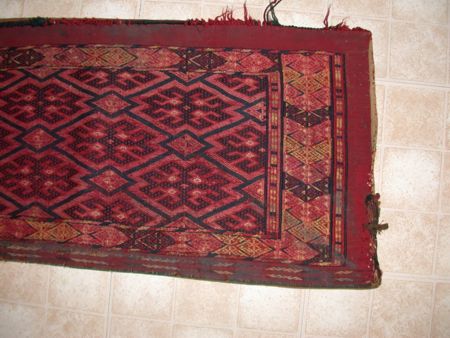
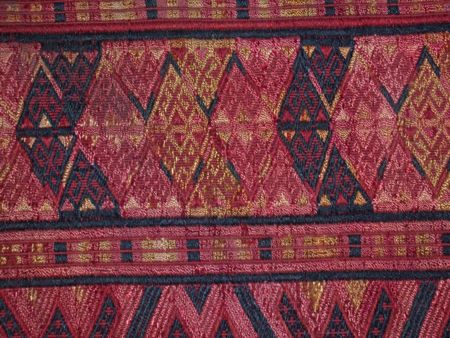
My piece is pretty fine work so possibly not Yomud but who knows - this seems to be before 1880. The silk is mostly 'one over' and the wool mostly 'three under/over ? - across three warps.'
Thanks
Kelvin Webb
From: Yon Bard
Kelvin, thanks for showing us your interesting piece. Could you please elaborate on your description of the structure? The statement "The silk is mostly 'one over' and the wool mostly 'three under/over ? - across three warps" isn't quite clear to me.
Regards, Yon
From: Ludwina Akbulut
Hello ,
I think the term Marla uses for this kind of weaving is : brocading overlay-underlay. (later some weeks I will recieve at last 'woven structures' and than we can speak the same language!)
Here in Turkey we call it cicim, also the Afgan people in carpet business use the same term, it is the same technique.
Best regards,
Ludwina Akbulut












